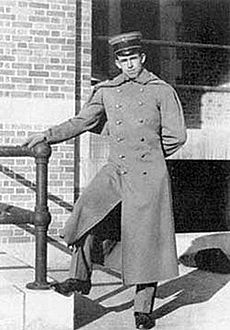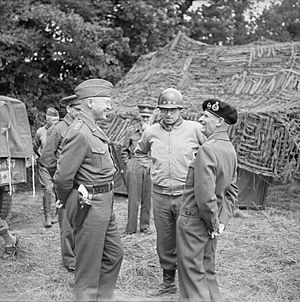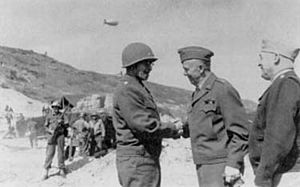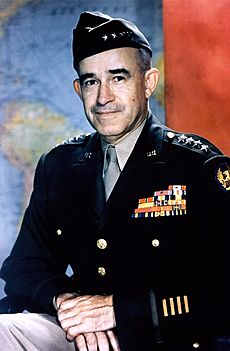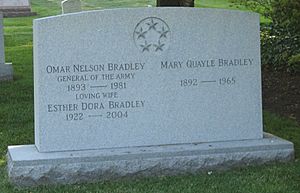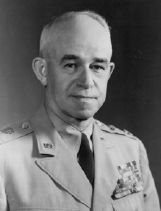Omar Bradley facts for kids
Quick facts for kids
Omar Bradley
|
|
|---|---|
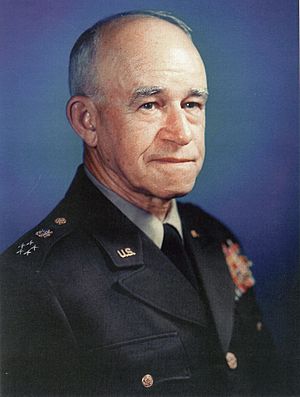 |
|
| 1st Chairman of the Joint Chiefs of Staff | |
| In office August 19, 1949 – August 15, 1953 |
|
| President | Harry Truman Dwight D. Eisenhower |
| Preceded by | William D. Leahy (as Chief of Staff to the Commander in Chief) |
| Succeeded by | Arthur W. Radford |
| Chief of Staff of the United States Army | |
| In office February 7, 1948 – August 15, 1949 |
|
| President | Harry S. Truman |
| Preceded by | Dwight D. Eisenhower |
| Succeeded by | J. Lawton Collins |
| Chair of the NATO Military Committee | |
| In office 5 October 1949 – 2 April 1951 |
|
| Preceded by | Office established |
| Succeeded by | Etienne Baele |
| Administrator of Veterans Affairs | |
| In office August 15, 1945 – November 30, 1947 |
|
| President | Harry S. Truman |
| Preceded by | Frank T. Hines |
| Succeeded by | Carl R. Gray Jr. |
| Personal details | |
| Born |
Omar Nelson Bradley
February 12, 1893 Clark, Missouri, U.S. |
| Died | April 8, 1981 (aged 88) New York City, U.S. |
| Resting place | Arlington National Cemetery |
| Education | United States Military Academy (BS) |
| Signature | |
| Nicknames | Brad The G.I.'s General |
| Military service | |
| Allegiance | United States |
| Branch/service | United States Army |
| Years of service | 1915–1981 |
| Rank | General of the Army |
| Unit | Infantry Branch |
| Commands | Chairman of the Joint Chiefs of Staff Chief of Staff of the United States Army 12th Army Group First Army II Corps 28th Infantry Division 82nd Infantry Division United States Army Infantry School 2nd Battalion, 14th Infantry Regiment |
| Battles/wars |
See battles
|
| Awards | Defense Distinguished Service Medal Army Distinguished Service Medal (4) Navy Distinguished Service Medal Silver Star Legion of Merit (2) Bronze Star Medal Presidential Medal of Freedom Complete list |
Omar Nelson Bradley (February 12, 1893 – April 8, 1981) was a very important officer in the United States Army. He served during and after World War II. He reached the highest rank, General of the Army, which is a five-star general.
Bradley was the first person to be the Chairman of the Joint Chiefs of Staff. This means he was the top military advisor to the President. He also helped guide the U.S. military during the Korean War. People often called him "The G.I.'s General" because he cared about the regular soldiers.
Born in Randolph County, Missouri, Bradley worked as a boilermaker before joining the West Point military school. He graduated in 1915 with Dwight D. Eisenhower. Their class was known for producing many future generals. During World War I, Bradley guarded copper mines in Montana.
After the war, he taught at West Point. He also worked for General George Marshall at the War Department. In 1941, he became the leader of the U.S. Army Infantry School.
When the U.S. entered World War II, Bradley helped turn the 82nd Infantry Division into the first American airborne (paratrooper) division. He led troops in North Africa and Sicily. He then commanded the First United States Army during the Normandy landings in France. Later, he led the Twelfth United States Army Group. This was the largest group of American soldiers ever under one commander, with 1.3 million men.
After World War II, Bradley led the Veterans Administration. He became the Chief of Staff of the United States Army in 1948. In 1949, he was named the first Chairman of the Joint Chiefs of Staff. He retired from active duty in 1953. He continued to serve in public and business roles until he passed away in 1981.
Early Life & Education
Omar Nelson Bradley grew up in a poor family in rural Randolph County, Missouri. His father was a schoolteacher and farmer. Omar was named after a local newspaper editor and a doctor. His family came from British ancestors who moved to Kentucky in the 1700s.
Omar's father taught him to love books, baseball, and shooting. When Omar was 15, his father died. His mother moved them to Moberly, Missouri. Bradley graduated from Moberly High School in 1910. He was a great student and athlete. He was captain of both the baseball and track teams.
He was working as a boilermaker when his Sunday school teacher told him about the West Point entrance exam. Bradley had been saving money to study law at the University of Missouri. He placed second in the West Point exam. The first-place winner couldn't go, so Bradley got the spot in August 1911.
At West Point, Bradley focused a lot on sports. He was a baseball star and was considered one of the best college players. He turned down offers to play professional baseball to stay in the Army. He graduated in 1915, ranking 44th in his class.
Early Military Career
After graduating from West Point, Bradley became a second lieutenant in the Infantry Branch. His first assignment was with the 14th Infantry Regiment. In 1915, he helped guard the U.S.-Mexico border.
When the U.S. entered World War I in 1917, he was promoted to captain. He was sent to guard important copper mines in Butte, Montana. He was supposed to go to Europe with the 19th Division, but the war ended before he could deploy.
Between the two World Wars, Bradley taught and studied. From 1920 to 1924, he taught math at West Point. He was promoted to major in 1924. He also took advanced infantry courses. After a short time in Hawaii, he studied at the U.S. Army Command and General Staff School in 1928–29.
After graduating, he taught tactics at the U.S. Army Infantry School. George Marshall, who was an assistant leader there, described Bradley as "quiet, unassuming, capable, with sound common sense. Absolute dependability."
Bradley was promoted to lieutenant colonel in 1936. He worked at the War Department, reporting directly to General Marshall. In 1941, he became a brigadier general and led the United States Army Infantry School. In 1942, he became a major general and commanded the 82nd Infantry Division.
World War II Leadership
Bradley's experiences during the war are shared in his book A Soldier's Story. This book was based on a detailed diary kept by his aide, Chester B. Hansen.
In March 1942, Bradley took command of the 82nd Infantry Division. He helped change it into the first American airborne division. He even took parachute training himself! Later, he commanded the 28th Infantry Division.
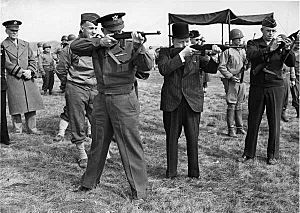
Bradley didn't get a front-line command until 1943, after the Allied invasion of French North Africa (Operation Torch). He was sent to North Africa to help Eisenhower with problems on the front lines. Bradley suggested changes to the II Corps after a tough defeat. General George S. Patton took command of II Corps, and Bradley became his deputy.
In April 1943, Bradley took over command of II Corps from Patton. He led them in the final battles of the Tunisia Campaign. His excellent work led to his promotion to lieutenant general in June 1943. He continued to lead II Corps in the Allied invasion of Sicily.
Normandy & Breakout
In October 1943, Bradley moved to London to prepare American ground forces for the invasion of France. For D-Day, Bradley was chosen to command the U.S. First Army. This army, along with the British Second Army, formed the 21st Army Group.
On June 10, 1944, Bradley set up his headquarters on shore in Normandy. He commanded three corps that attacked Utah Beach and Omaha Beach. In July, he planned Operation Cobra. This operation aimed to break out of the Normandy beachhead. It used strategic bombers to attack German defenses.
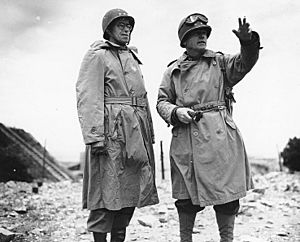
Operation Cobra began on July 25, 1944. The bombing confused German troops, making them ineffective. Bradley sent in three infantry divisions right after the bombing. They broke through German defenses, allowing armored forces to move around the German lines.
As more troops arrived in Normandy, the Third Army was formed under General Patton. Bradley then commanded the 12th Army Group. This group grew to over 900,000 men. It eventually had four armies, making it the largest group of American soldiers ever under one field commander.
Falaise Pocket & Germany
After a German attack at Mortain, Bradley's Army Group helped form the Falaise pocket. This trapped the German Seventh Army and Fifth Panzer Army in Normandy. However, Bradley stopped his troops from pushing further north, leaving a gap. This allowed around 20,000–50,000 German troops to escape. They left most of their heavy equipment behind. This decision was criticized, but Bradley believed most Germans had already escaped and worried about friendly fire.
American forces reached the "Siegfried Line" in late September. The Allied armies had advanced faster than expected, causing fuel shortages. Bradley wanted to advance into the Saarland. However, Eisenhower agreed to Operation Market Garden, a plan by British Field Marshal Montgomery to cross the Lower Rhine. Bradley opposed this plan and complained about supplies going to Montgomery.
Bradley's Army Group covered a wide area from the Netherlands to Lorraine. He faced challenges fighting in difficult terrain against a skilled enemy. Bradley and his First Army commander, General Courtney Hodges, decided to attack through the Aachen Gap. This led to the costly Battle of Hurtgen Forest, which resulted in about 33,000 American casualties.
Battle of the Bulge
Bradley's command faced the first attacks of the Battle of the Bulge. For a time, Eisenhower placed Bradley's First and Ninth Armies under British Field Marshal Montgomery's command. Bradley was very upset by this decision.
Victory in Europe
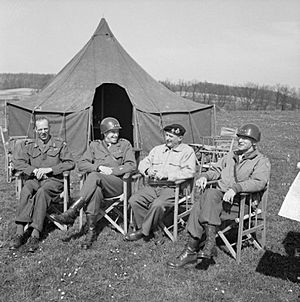
In March 1945, Bradley's forces broke through German defenses. They crossed the Rhine River into Germany's industrial heartland. The capture of a bridge at Remagen helped Bradley encircle German forces in the Ruhr. Over 300,000 German prisoners were taken. American forces then met Soviet forces near the Elbe River in mid-April. By V-E Day, Bradley's 12th Army Group had over 1.3 million men.
Command Style

Unlike some other generals, Bradley was known for being polite and courteous. War correspondent Ernie Pyle called him the GI's general. This nickname stayed with him. Will Lang Jr. of Life magazine noted Bradley's "gentleness."
Some people, like combat historian S. L. A. Marshall, said that the "common man" image was mostly from the media. Marshall said that soldiers didn't really know Bradley well because he didn't visit troops often.
Bradley was sometimes criticized for his leadership style. British General Bernard Montgomery described him as "dull, conscientious, dependable, and loyal." Bradley would sometimes remove commanders he felt were too independent. He was also a strict disciplinarian when needed.
Post-War Service
Veterans Administration
After the war, President Truman asked Bradley to lead the Veterans Administration for two years (1945-1947). He greatly improved its health care system. He also helped veterans get their education benefits under the G. I. Bill of Rights. Bradley's work helped shape the VA into what it is today. He often spoke to Congress to support veterans' benefits.
Chairman of the Joint Chiefs of Staff
Bradley became the Army Chief of Staff in 1948. He found the U.S. military needed a lot of changes and new equipment. He said, "the Army of 1948 could not fight its way out of a paper bag."
On August 11, 1949, President Harry S. Truman appointed Bradley the first Chairman of the Joint Chiefs of Staff. In 1950, he was promoted to General of the Army, becoming the fifth and last person to reach this five-star rank. That same year, Bradley became the first Chairman of the NATO Military Committee. He stayed on the committee until August 1953, when he left active duty.
Korean War
As Chairman of the Joint Chiefs of Staff, Bradley was the top military officer when the Korean War began. In June 1950, North Korea invaded South Korea. Bradley had to quickly organize and send American troops. The U.S. military was not ready due to budget cuts. Poorly equipped American troops were pushed back to Pusan.
Bradley was a key military leader during the Korean War. He first supported conquering all of North Korea. But when Chinese forces entered the war, American forces were pushed back again. Bradley then agreed that the goal should change to containment of North Korea. This meant stopping the spread of communism.
Bradley also helped convince President Truman to remove General Douglas MacArthur from command. MacArthur wanted to expand the war, but Bradley and Truman wanted to limit it. Bradley famously told Congress that MacArthur's plan would involve the U.S. in "the wrong war, at the wrong place, at the wrong time, and with the wrong enemy."
Retirement & Legacy
Bradley left active military service in August 1953. He remained on active duty because of his high rank. He led the "Bradley Commission" in 1955–1956, which looked at veterans' pensions. He also became a founding member of the President's Board of Consultants on Foreign Intelligence Activities.
In retirement, Bradley worked in business. He was Chairman of the Board for the Bulova Watch Company from 1958 to 1973. He often visited his hometown of Moberly, Missouri. He enjoyed playing golf and was a big fan of college football.
His memoir, A Soldier's Story, was published in 1951. He started another autobiography, A General's Life, which was finished by Clay Blair after Bradley's death. In this book, Bradley criticized Field Marshal Montgomery's claims about the Battle of the Bulge.
Bradley's first wife, Mary, died in 1965. He married Esther Dora "Kitty" Buhler in 1966.
In 1967–1968, Bradley advised President Lyndon B. Johnson on the Vietnam War. He recommended against withdrawing troops. After Dwight D. Eisenhower died in 1969, Bradley was the only surviving five-star officer in the U.S. Armed Forces.
In 1970, Bradley was a consultant for the film Patton. The movie was based on his memoir.
Bradley attended the 30th and 35th anniversaries of D-Day in Normandy, France. On January 10, 1977, he received the Presidential Medal of Freedom from President Gerald Ford.
Omar Bradley passed away on April 8, 1981, in New York City. He is buried at Arlington National Cemetery with his two wives. He served on active duty for almost 70 years, the longest career in U.S. Armed Forces history.
Bradley is remembered for saying, "Ours is a world of nuclear giants and ethical infants. We know more about war than about peace, more about killing than we know about living."
The U.S. Army's M2 Bradley infantry fighting vehicle and M3 Bradley cavalry fighting vehicle are named after him. His hometown, Moberly, Missouri, plans a library and museum in his honor. In 2010, his birthday was recognized as General Omar Nelson Bradley Day. In 2000, the United States Postal Service honored him with a stamp. There is also an elementary school named after him at Fort Leavenworth, Kansas.
Summary of Service
Assignment History
- August 1, 1911: Cadet, West Point
- June 12, 1915: 14th Infantry Regiment
- September 10, 1919: ROTC professor, South Dakota State College
- September 13, 1920: Instructor, United States Military Academy
- September 15, 1924: Infantry School Student, Fort Benning, Georgia
- October 1, 1925: Battalion Commander, 27th Infantry Regiment
- June 10, 1927: Office of National Guard and Reserve Affairs, Hawaiian Department
- August 31, 1928: Student, Command and General Staff School
- August 1, 1929: Instructor, United States Army Infantry School, Fort Benning, Georgia
- August 18, 1933: Student, United States Army War College
- June 30, 1934: Plans and Training Officer, United States Military Academy
- June 1, 1938: War Department General Staff, G-1 Chief of Operations Branch and Assistant Secretary of the General Staff
- March 5, 1941: Commandant, U.S. Army Infantry School, Fort Benning, Georgia
- February 19, 1942: Commanding General, 82nd Infantry Division
- June 25, 1942: Commanding General, 28th Infantry Division
- April 16, 1943: Commanding General, II Corps, North Africa and Sicily
- September 9, 1943: Commanding General, Field Forces European Theater
- March 6, 1944: Commanding General, First Army
- August 1, 1944: Commanding General, 12th Army Group
- August 15, 1945: Administrator of Veterans Affairs, Veterans Administration
- February 7, 1948: United States Army Chief of Staff
- August 15, 1949: Chairman of the Joint Chiefs of Staff
- August 19, 1953: Remained on active duty without an assignment
Awards & Decorations
| Defense Distinguished Service Medal | |
| Army Distinguished Service Medal with three oak leaf clusters | |
| Navy Distinguished Service Medal | |
| Silver Star | |
| Legion of Merit with oak leaf cluster | |
| Bronze Star Medal | |
| Presidential Medal of Freedom | |
| Mexican Border Service Medal | |
| World War I Victory Medal | |
| Army of Occupation of Germany Medal | |
| American Defense Service Medal | |
| American Campaign Medal | |
| European-African-Middle Eastern Campaign Medal with Arrowhead device, one silver and two bronze campaign stars | |
| World War II Victory Medal | |
| Army of Occupation Medal with "Germany" clasp | |
| National Defense Service Medal with oak leaf cluster | |
| Korean Service Medal | |
| United Nations Service Medal |
Foreign Awards
 Grand Cross, Legion of Honour (France)
Grand Cross, Legion of Honour (France) Grand Cross, Order of the Crown (Belgium)
Grand Cross, Order of the Crown (Belgium) Grand Cross, Order of the Oak Crown (Luxembourg)
Grand Cross, Order of the Oak Crown (Luxembourg) Grand Cross, Order of George I (Greece)
Grand Cross, Order of George I (Greece) Grand Cross, Order of the Phoenix (Greece)
Grand Cross, Order of the Phoenix (Greece) Grand Cross, Military Order of Savoy (Italy)
Grand Cross, Military Order of Savoy (Italy) Honorary Knight Commander of the Order of the Bath (United Kingdom)
Honorary Knight Commander of the Order of the Bath (United Kingdom) Grand Officer, Order of the Liberator (Argentina)
Grand Officer, Order of the Liberator (Argentina) Grand Officer, Order of Military Merit (Brazil)
Grand Officer, Order of Military Merit (Brazil) Grand Officer, Order of Orange-Nassau (Netherlands)
Grand Officer, Order of Orange-Nassau (Netherlands) Commander, Order of the White Lion (Czechoslovakia)
Commander, Order of the White Lion (Czechoslovakia) Commander of the Order of Ouissam Alaouite (Morocco)
Commander of the Order of Ouissam Alaouite (Morocco) Commander's Cross of the Order of Polonia Restituta (Poland)
Commander's Cross of the Order of Polonia Restituta (Poland) Order of Suvorov (1st class) (Soviet Union)
Order of Suvorov (1st class) (Soviet Union) Order of Kutuzov (1st class) (Soviet Union)
Order of Kutuzov (1st class) (Soviet Union)
 French Croix de guerre with silver-gilt palm
French Croix de guerre with silver-gilt palm War Cross WWII (Belgium) with palm
War Cross WWII (Belgium) with palm Czechoslovak War Cross 1939–1945
Czechoslovak War Cross 1939–1945 Luxembourg War Cross
Luxembourg War Cross Queen Elizabeth II Coronation Medal
Queen Elizabeth II Coronation Medal
Dates of Rank
| No insignia | Cadet, United States Military Academy: August 1, 1911 |
| No pin insignia in 1915 | Second Lieutenant, United States Army: June 12, 1915 |
| First Lieutenant, United States Army: July 1, 1916 | |
| Captain, United States Army: May 15, 1917 | |
| Temporary Major, National Army: June 17, 1918 to January 22, 1920 | |
| Major, National Army: July 1, 1920 | |
| Captain, Regular Army (reverted to permanent rank): November 4, 1922 | |
| Major, Regular Army: June 25, 1924 | |
| Lieutenant Colonel, Regular Army: July 26, 1936 | |
| Brigadier General, Army of the United States: February 24, 1941 | |
| Major General, Army of the United States: February 15, 1942 | |
| Lieutenant General, Army of the United States: June 2, 1943 | |
| Colonel, Regular Army: October 1, 1943 | |
| Brigadier General, Regular Army: September 1, 1943 | |
| Major General, Regular Army: September 8, 1944 | |
| General, Army of the United States: March 12, 1945 | |
| General, Regular Army: January 31, 1949 | |
 |
General of the Army, Regular Army: September 22, 1950 |
Images for kids
-
Lesley J. McNair listens as Omar Bradley, 82nd Infantry Division commander, explains a scenario to McNair at the Louisiana Maneuvers
See also
 In Spanish: Omar Bradley para niños
In Spanish: Omar Bradley para niños


